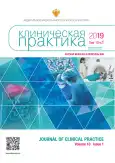Harlequin’s face — a rare form of autonomic dysfunction during dissection of the internal carotid artery
- Authors: Belopasov V.V.1, Gubanova M.V.2, Belopasova A.V.2, Kalashnikova L.A.3, Dobrinina L.A.3
-
Affiliations:
- Astrakhan State Medical University
- Research Center for Neurology
- Research Center of Neurology
- Issue: Vol 10, No 1 (2019)
- Pages: 88-93
- Section: Case reports
- URL: https://journals.rcsi.science/clinpractice/article/view/10836
- DOI: https://doi.org/10.17816/clinpract10188-93
- ID: 10836
Cite item
Full Text
Abstract
A comprehensive examination and dynamic observation of a patient with clinical manifestations of connective tissue dysplasia and dissection of the internal carotid arteries revealed a symptom complex characteristic of Harlequin syndrome. The description of this form of pathology is given for the first time in the national literature. A brief review presents the diagnostic criteria and mechanisms for the development of this rare autonomic dysfunction.
Full Text
##article.viewOnOriginalSite##About the authors
Vladimir V. Belopasov
Astrakhan State Medical University
Email: belopasov@yandex.ru
ORCID iD: 0000-0003-0458-0703
SPIN-code: 6089-1321
doctor of medical sciences, professor Head of the Department of Neurology and Neurosurgery with a course of postgraduate education
Russian Federation, 121, Bakinskaya Street, Astrakhan, 414000Maria V. Gubanova
Research Center for Neurology
Email: m.v.gubanova@yandex.ru
SPIN-code: 9341-4397
neurologist of the 3 neurological department
Russian Federation, 125367, Moscow, Volokolamskoye sh., 80Anastasia V. Belopasova
Research Center for Neurology
Author for correspondence.
Email: mastusha@yandex.ru
ORCID iD: 0000-0003-3124-2443
SPIN-code: 3149-3053
Candidate of Medical Science, Researcher of the 3 neurology department
Russian Federation, 125367, Moscow, Volokolamskoye sh., 80Ludmila A. Kalashnikova
Research Center of Neurology
Email: kalashnikovancn@yandex.ru
SPIN-code: 4424-3678
doctor of medical sciences, professor, chief research officer of the 3 neurological department
Russian Federation, 125367, Moscow, Volokolamskoye sh., 80Larisa A. Dobrinina
Research Center of Neurology
Email: dobrla@mail.ru
SPIN-code: 2824-8750
doctor of medical sciences, head of the 3 neurological department
Russian Federation, 125367, Moscow, Volokolamskoye sh., 80,References
- Губанова, М.В., Калашникова Л.А., Добры-нина Л.А., и соавт. Маркеры дисплазии соединительной ткани при диссекции магистральных артерий головы и провоцирующие факторы диссекции // Анналы клинической и экспериментальной неврологии. — 2017. — Т.11. — №4. — С. 19–28. [Gubanova МV, Kalashnikova LА, Dobrynina LА, et al. Markers of connective tissue dysplasia in cervical artery dissection and its predisposing factors. Annaly klinicheskoj i eksperimental’noj nevrologii. 2017;11(4):19–28. (In Russ).]
- Калашникова Л.А., Добрынина Л.А., Корепина О.С., и соавт. Анамнестическая головная боль у больных с диссекцией магистральных артерий головы: клинические особенности и механизмы развития // Журнал неврологии и психиатрии им. С.С. Корсакова. — 2018. — Т.118. — №7. — С. 4–11. [Kalashnikova LA, Dobrynina LA, Korepina OS, et al. Anamnestic headache in patients with cervical artery dissection: clinical characteristics and pathogenetic mechanisms. Zhurnal nevrologii i psikhiatrii imeni S.S. Korsakova. 2018;118(7):4–11. (In Russ).]
- Lance JW, Drummond PD, Gandevia SC, Morris JG. Harlequin syndrome: the sudden onset of unilateral flushing and sweating. J Neurol Neurosurg Psychiatry. 1988;51(5):635–642.
- Rousseaux M, Hurtevent JF, Benaim C, Cassim F. Late contralateral hyperhidrosis in lateral medullary infarcts. Stroke. 1996;27:991–995.
- Burlacu CL, Buggy DJ. Coexisting harlequin and Horner syndromes after high thoracic paravertebral anaesthesia. Br J Anaesth. 2005;95(6):822–824. doi: 10.1093/bja/aei258.
- Zinboonyahgon N, Srinivasan S, Narang S. Harlequin syndrome following implantation of intrathecal pumps: a case series. Neuromodulation. 2015;18(8):772–775. doi: 10.1111/ner.12343.
- Wasner G, Maag R, Ludwig J, et al. Harlequin syndrome — one face of many etiologies. Nat Clin Pract Neurol. 2005;1(1):54–59. doi: 10.1038/ncpneuro0040.
- Lee DH, Seong JY, Yoon TM, et al. Harlequin syndrome and Horner syndrome after neck schwannoma excision in a pediatric patient: A case report. Medicine (Baltimore). 2017;96(45):e8548. doi: 10.1097/MD.0000000000008548.
- Hans-Bittner NR, Bittner GC, Hans Filho G. Do you know this syndrome? Harlequin syndrome. An Bras Dermatol. 2018;93(4):585–586. doi: 10 1590/abd1806-4841.20187549.
- Lefevre A, Schnepper G. Development of Harlequin Syndrome following placement of thoracic epidural anesthesia in a pediatric patient undergoing. Clin Case Rep. 2017;5(9):1523–1525. doi: 10.1002/ccr3.1097.
- Yu Phuan CZ, Tey HL. Unilateral facial and upper truncal anhidrosis and absence of physiological flushing: a case of idiopathic harlequin syndrome. Indian J Dermatol Venereol Leprol. 2017;83(6):740. doi: 10.4103/ijdvl.IJDVL_767_16.
- Caparros-Lefebvre D, Hache JC, Hurtevent JF, et al. Unilateral loss of facial flushing and sweating with contralateral anhidrosis: harlequin syndrome or Adie’s syndrome? Clin Auton Res. 1993;3(4):239–241.
- Algahtani H, Shirah B, Algahtani R, Alkahtani A. Idiopathic Harlequin syndrome manifesting during exercise: a case report and review of the literature. Case Rep Med. 2017;2017:5342593. doi: 10.1155/2017/5342593.
- Vidal Esteban A, Natera-de Benito D, Martinez Sanchez D, et al. Congenital harlequin syndrome as an isolated phenomenon: a case report and review of the literature. Eur J Paediatr Neurol. 2016;20(3):426–430. doi: 10.1016/j.ejpn.2016.02.004.
Supplementary files









